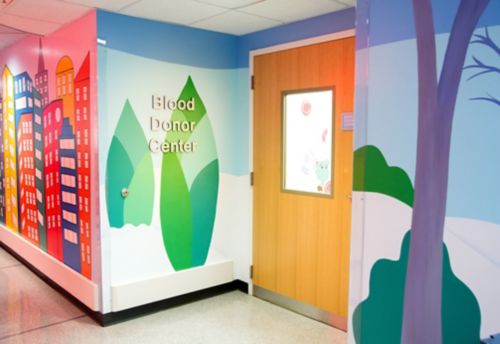Contact the Blood Donor Center
Blood Donor Center
St. Jude Children’s Research Hospital
262 Danny Thomas Place
Memphis, TN 38105-3678
- Phone: 901-595-2024
- Toll-Free: 866-278-5833, ext. 2024
- Email: BloodDonor.Recruiters@stjude.org
St. Jude Family of Websites
Explore our cutting edge research, world-class patient care, career opportunities and more.
St. Jude Children's Research Hospital Home


Patients frequently need blood products to treat their disease or manage treatment side effects. If you are eligible, please consider donating blood and blood products at our St. Jude Children’s Research Hospital Blood Donor Center.
At the Blood Donor Center, you can donate either platelets or whole blood. All blood products collected at our center go directly to St. Jude patients. By donating, you help us save money. It means we do not have to buy blood from other sources as often.
Note that we are not able to accept blood donations that are not collected at the St. Jude Blood Donor Center.
Platelets are a part of whole blood. These blood cells help the body form blood clots and stop bleeding from injuries. A healthy person has about 150,000–450,000 platelets in their blood. Platelets stay in the bloodstream for 9–10 days.
When a child has chemotherapy, their platelet count can get too low (known as thrombocytopenia). This can lead to dangerous blood loss if they are injured, and their blood vessels could leak.
The Blood Donor Center collects platelets by a process called apheresis, or plateletpheresis. We draw blood from the donor. The blood is then separated into its parts inside a machine. The platelets are collected and the rest of the blood is returned to the donor. This process continues until we collect a whole unit of platelets. The unit has about 5-6 times more platelets than a unit of whole blood.
A platelet donation takes about 2 hours. You can donate platelets every 7 days. But you cannot donate more than 24 times in one year.
To donate platelets, you must meet certain requirements. You must not take aspirin or aspirin-containing products for 48 hours before your platelet donation. Aspirin-containing products include medications such as:
Call the Blood Donor Center to find out if your pain reliever contains aspirin.
We remove about 1 pint (500 ml) of blood from the donor during a whole blood donation. For this type of donation, we do not separate the different parts of the blood.
Your body can make more of the fluid you lose from your donation in about 24 hours. Your body will replace red blood cells lost from the donation in a few weeks.
A whole blood donation takes about 30 minutes. You can donate blood every 8 weeks. You must meet certain eligibility requirements to donate blood. Contact the St. Jude Blood Donor Center for more information.
Blood Donor Center
St. Jude Children’s Research Hospital
262 Danny Thomas Place
Memphis, TN 38105-3678